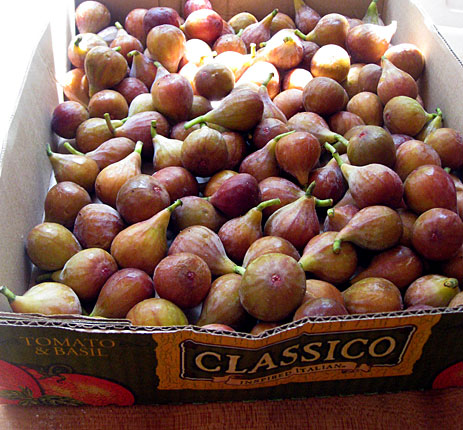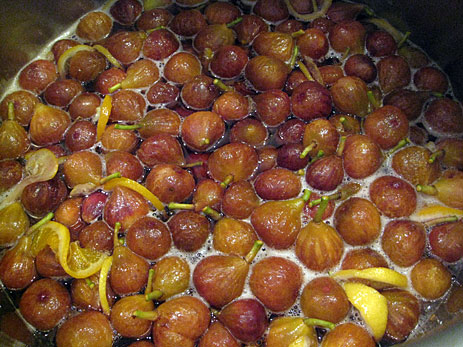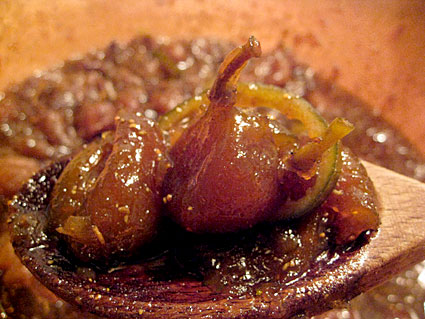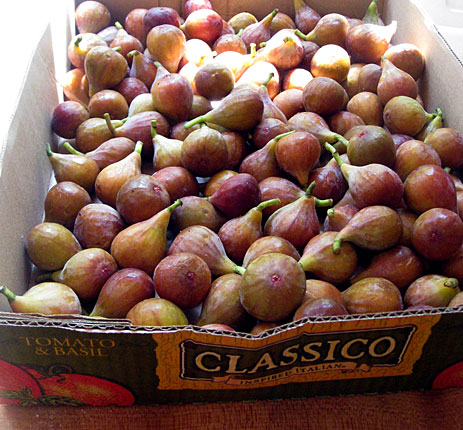 (April McGreger photos)I’m embarrassed to admit just how powerful an influence the two enormous fig trees on the property were on the purchase of my new home. Later, when choosing paint colors for the house, my husband, an artist, suggested pulling from other color combinations that capture my imagination. Again, the first thought I had was figs. With color variations in their skins from apple-green to bronze to violet, and their delicate strawberry middles, is there anything more beautiful than a fig?
(April McGreger photos)I’m embarrassed to admit just how powerful an influence the two enormous fig trees on the property were on the purchase of my new home. Later, when choosing paint colors for the house, my husband, an artist, suggested pulling from other color combinations that capture my imagination. Again, the first thought I had was figs. With color variations in their skins from apple-green to bronze to violet, and their delicate strawberry middles, is there anything more beautiful than a fig?
I am certainly not the first person to derive inspiration from a fig tree. The ancients wrote poetry and sang songs about figs; Buddha attained enlightenment while sitting under a fig tree; and fig trees are one of the first plants mentioned in the Bible, as well as the subject of more than one Biblical parable.
While we have established that figs are my muse as well as the ancients’, I haven’t yet mentioned their exquisite taste. Eating fresh figs is so sensual that it practically makes me blush. It is an experience that I missed out on for most of my life, since I almost always ate them cooked. The juicy, fleshy texture and musky sweetness with hints of grass, vanilla, and honey have been truly a revelation to me in recent years. Likewise, our Southeastern figs are so perishable, and their season so brief, that savoring them at that perfect moment of ripeness feels incredibly fortuitous.
As remarkable as a fresh fig may be, in the South it is the preserved fig that reigns supreme. We do not make fig jam, but instead preserve our small Brown Turkey and Celeste varieties whole in a syrup flavored with paper-thin slices of lemon and ginger. There is no pleasure greater than eating a hot buttermilk biscuit halved, buttered and topped with a perfect syrupy fig, alongside a fresh cup of coffee sitting at the table at your mama’s house.
Now, in my rural Mississippi experience, that is as far as we got with our fig repertoire. We never had more figs than we could use for our single, favorite purpose.
Living here in North Carolina, however, I find myself neighboring the center of the East Coast fig universe. In coastal North and South Carolina, figs are so plentiful that people make fig cobblers and fig ice cream, and have adapted the widespread Southern tradition of jam cake (which my grandmother always made with blackberry preserves) to their prized fig preserves. I am not sure where the fig cake originated, but it is certainly nowhere more popular than on Ocracoke Island, North Carolina. There it is made into bundt cakes and more elaborate layer cakes with cream-cheese frosting. If you’re lucky you might even find it sold by the slice on the counter of the local fish market.
On the North Carolina coast, fig trees dot the landscape. Countless beach rentals on Ocracoke Island have a fig tree planted next to the cottage, but the tourists are mostly gone before the figs begin to ripen. (You can add fig season to your list of reasons to wait until August or September to take your Carolina beach vacation.)
Come August, locals round them all up for making enormous quantities of whole fig preserves. Some families make a quart of fig preserves for every week of the year and put them on the table at each meal. Most of the preserves are baked into cakes, eaten on hot biscuits, given away as gifts, and sold to locals and expatriates. By Christmastime, the best ones are gone until the next fig harvest.
I first stumbled onto to the legendary Ocracoke Island Fig Cake in Nancie McDermott’s charming book, Southern Cakes. I highly recommend it to all the bakers out there, particularly if you’re interested in regional cakes with a compelling history in this world of baking anonymity. Below, I have adapted McDermott’s wonderful, decadent cake to something a bit more healthful but just as delicious. I use whole-grain flour, cut back slightly on the amount of oil, double the amount of preserves, and cut out the additional sugar altogether. I also halve the amount of spices called for because I appreciate their subtlety and prefer that the spiciness of the cake doesn’t mask the fig flavor.
In addition, I couldn’t resist following the wisdom of folks on Hatteras Island who, according to Elizabeth Weigand in The Outer Banks Cookbook, put their own twist on the fig cake by adding a shot of whiskey to the batter.
My wholesome version of this storied cake makes a perfect brunch or snack cake. If you’re looking for more decadence, slather it with your favorite cream-cheese frosting like the folks on Ocracoke Island do for special occasions.
Ocracoke Island Fig Cake, My Way
Adapted from Southern Cakes by Nancie McDermott
Cake
3 eggs
3/4 cup safflower or other vegetable oil
2 cups whole-wheat pastry flour (or substitute up to 1 cup with either spelt or buckwheat flour)
1/2 teaspoon nutmeg
1/4 teaspoon allspice
1/4 teaspoon cinnamon
1 teaspoon salt
1 teaspoon baking soda
1/2 cup buttermilk
1 teaspoon vanilla
2 tablespoons whiskey or bourbon, optional
2 cups coarsely chopped fig preserves (recipe below), or you may substitute fig jam
1 cup coarsely chopped toasted walnuts
Buttermilk glaze
1/2 cup buttermilk*
1/2 cup unrefined sugar, such as Rapadura or Muscavado
1/4 cup butter
1 1/2 teaspoon cornstarch
1/4 teaspoon baking soda
1 teaspoon vanilla
Preheat the oven to 350 degrees. Grease and flour a 10-inch tube or bundt pan and set aside. Beat the eggs well until light yellow and smooth. Add the sugar and oil and continue beating well to make a thick, smooth batter.
Whisk together the flour(s), nutmeg, allspice, cinnamon, salt, and baking soda in a medium bowl until well-blended. Add half the flour mixture to the egg-and-sugar mixture and stir with a wooden spoon to blend well. Add the buttermilk, vanilla, and bourbon if using and mix well. Add the remaining flour and stir gently until well blended. Gently fold in the chopped figs and the walnuts.
Scrape the batter into the prepared pan, and bake at 350 degrees for 40 to 50 minutes until the cake is brown and firm to the touch on top. It should spring back when you gently press it and a wooden skewer inserted in the center of the cake should come out clean. While the cake bakes, prepare the buttermilk glaze.
Combine the buttermilk, raw sugar, butter, cornstarch, and baking soda in a medium saucepan and bring to a gentle boil. Remove at once, stir well, and cool to room temperature. Add the vanilla, and set aside until the cake is done.
When the cake is done, remove it from the oven and cool it in the pan on a wire rack for about 15 minutes. Loosen the cake from the pan gently, running a table knife around the sides of the pan, and then turn it out onto the wire rack. Carefully transfer the cake right side up to a serving plate or cake stand, then spoon the glaze over the warm cake.
Covered tightly, this cake will keep for about a week.
*If you don’t have buttermilk, stir 1 tablespoon of vinegar or lemon juice into 1 cup of milk, and let stand for 10 minutes. Vegans and/or the lactose intolerant can substitute soy yogurt for the buttermilk and 1/2 cup pureed silken tofu for the eggs. You could skip the glaze altogether and simply top the cake with a sprinkle of crunchy, unrefined sugar before b
aking; or substitute a simple vegan lemon glaze or your favorite vegan cream-cheese icing as a topping.
 Simmering the figs with ginger and lemon for preserves.Old-fashioned whole-fig preserves
Simmering the figs with ginger and lemon for preserves.Old-fashioned whole-fig preserves
You can use any variety of fig to make these whole-fig preserves, but traditionally they are made with Brown Turkey and Celeste (or Sugar Fig) varieties.
Yields 5 to 6 half-pint jars
8 cups small, firm but ripe figs
2 cups sugar (unrefined sugar can be substituted)
1-inch knob of fresh ginger, peeled and thinly sliced
1 small lemon, thinly sliced
juice of another lemon
about 1 cup of water
In a wide, heavy-bottomed, nonreactive pot, layer the figs with the lemon slices, sugar, sliced ginger, and lemon juice. Cover and refrigerate at least 4 hours or overnight.
The next day, add the cup of water and cover the pot with a lid or a piece of aluminum foil. Bring the figs to a simmer over medium heat. Turn the figs down to low and cook covered for 1 hour.
After the figs have cooked covered for 1 hour, vent the lid and cook for another half hour with the lid vented (half-on) or until the figs are translucent and the syrup has thickened.
Transfer the figs to sterilized jars and refrigerate or process for 5 minutes in a water-bath canner to store on the shelf.
 Spiced preserved figs are a new twist on my old favorite.Variation: Garam masala spiced figs
Spiced preserved figs are a new twist on my old favorite.Variation: Garam masala spiced figs
Although there’s nothing I love more than perfect whole fig preserves with slithers of lemon peel on hot buttered biscuits, these spiced figs open up a whole new savory world for my preserved figs. I love them with crusty bread, thinly sliced country ham or prosciutto, aged cheeses, and a nice bottle of wine for a luxurious picnic or easy entertaining. They are also wonderful beside pork tenderloin, in a salad with toasted walnuts, or just eaten straight out of the jar!
This recipe is essentially traditional fig preserves with sautéed shallots and the Indian spice mix garam masala added to the final simmer. You may begin with your own favorite recipe for fig preserves or start with mine. In this savory version, I cut back on the sugar slightly. Also, if you have a favorite spice that you’d like to use instead of the garam masala, feel free to experiment. Start with a reserved amount and add more if you wish.
1 1/2 tablespoons extra-virgin olive oil
2 teaspoons garam masala*
2 tablespoons peeled and finely chopped shallots
Pinch of salt
Make the fig preserves as described above through step 2. If you prefer, you may replace the lemons with limes. While the preserves are cooking, heat olive oil in a small skillet. Add the garam masala, shallots, and a pinch of salt and sauté over medium heat for about 2 to 3 minutes, or until the shallots are soft and the spices smell toasty. Remove from heat and set aside.
After the figs have cooked covered for 1 hour, vent the lid, very gently stir in the spiced shallot mixture, and cook for another half hour with the lid vented (half on) or until the figs are translucent and the syrup has thickened.
*You can purchase garam masala in Indian markets and many health food stores, or you can make your own blend, next.
Garam masala
1-inch stick of cinnamon, broken into pieces
1 bay leaf
2 tablespoon cumin seed
3 tablespoons coriander seed
2 teaspoons green cardamom pods
2 teaspoons black peppercorns
1 teaspoon cloves
Pinch of chili flakes
Pinch of freshly grated nutmeg or ground mace
Combine all of the spices, except the nutmeg or mace, in a skillet over medium heat. Stir constantly for about 2 minutes or until the spices are fragrant and beginning to brown just slightly.
Grind in a spice grinder — I have one coffee grinder for grinding coffee and another just for grinding spices — until a fine powder, then stir in the nutmeg or ground mace. In a tightly covered container, it will keep for about 6 months.


